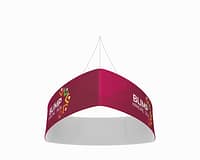In the world of museums and exhibitions, visual storytelling is paramount. Every artifact, every display, and every wall has a tale to tell. In this realm, fabric banners emerge as a versatile and powerful tool to elevate the aesthetic and educational experience of visitors. This article delves into the reasons why fabric banners are an essential asset for museums and exhibitions, showcasing their unique ability to enhance the atmosphere and captivate audiences.
Elevate Your Space: The Power of Fabric Banners in Museums
Fabric banners possess an innate ability to transform spaces, infusing them with vibrancy and character. Unlike traditional signage that can often feel rigid and uninspired, fabric banners offer a softer, more inviting appearance. They can be draped, hung, or displayed in myriad ways, allowing curators to experiment with form and design. The fluid nature of fabric allows for creative shapes and arrangements, enabling museums to break away from monotonous layouts and create immersive environments that draw visitors in.
Moreover, fabric banners can be tailored to match the thematic essence of an exhibition. With the use of high-quality prints and custom designs, museums can reflect their unique narrative through color, texture, and imagery. For instance, an exhibit focusing on ancient civilizations can utilize earthy tones and natural fibers, while a contemporary art installation might call for bold graphics and sleek finishes. This versatility not only enhances the overall aesthetic but also serves to strengthen the connection between the content and the space, making the visitor experience more cohesive and engaging.
In addition to their visual impact, fabric banners are also practical and efficient. Lightweight yet durable, they are easy to transport and install, making them ideal for traveling exhibitions or temporary displays. Their resilience against wear and tear means they can be reused across multiple events, offering museums a cost-effective solution without compromising their artistic vision. The ability to quickly switch out banners also allows for dynamic programming, keeping exhibitions fresh and engaging for repeat visitors.
Captivating Displays: How Fabric Banners Enhance Exhibitions
When it comes to storytelling, fabric banners excel at encapsulating narratives in a visually striking manner. With the capacity for high-resolution printing, they can showcase intricate details, vivid colors, and compelling graphics that draw the eye. This capability is essential in exhibitions where every detail counts; a well-designed banner can set the tone for the entire display, steering the visitor’s emotional journey from the moment they step into the space. By using imagery that resonates with the theme, museums can elicit curiosity and provoke thought, enriching the educational experience.
Furthermore, fabric banners can serve a multitude of functions within an exhibition. They can act as informative backdrops, interactive elements, or even standalone art pieces. For example, a banner might highlight key historical figures or events, providing context and depth to the artifacts on display. In interactive installations, fabric banners can guide visitors through the narrative, leading them from one element to the next with ease. Such functionality ensures that the exhibition remains not only visually appealing but also intellectually stimulating, encouraging deeper engagement with the subject matter.
The adaptability of fabric banners also extends to their placement within the exhibition space. They can be used in various formats — from large backdrops that envelop an entire room to smaller banners that complement specific artifacts. This flexibility allows curators to design a flow that guides visitors intuitively through the exhibition, enhancing their overall experience. By effectively using space and creating focal points, fabric banners can help museums tell their stories in captivating ways, ensuring that visitors leave with lasting impressions.
In conclusion, fabric banners are an invaluable asset for museums and exhibitions, providing a unique blend of aesthetic appeal, functionality, and versatility. Their ability to elevate spaces and enhance storytelling makes them an essential tool in the curator’s toolkit. As museums continue to evolve and adapt to the changing landscape of public engagement and education, the strategic use of fabric banners will undoubtedly play a vital role in captivating audiences and enriching the visitor experience. Embracing this creative medium is not just a trend; it’s a commitment to creating immersive environments that resonate deeply with every visitor.



